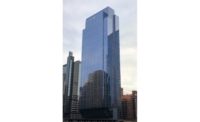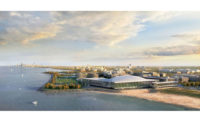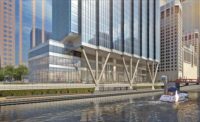Design Firm of the Year Goettsch Partners Turns Challenges Into Bold Solutions

Three 55-ft-tall steel tridents form a five-story-high riverwalk public space at 110 N. Wacker. It’s the first of its kind in Chicago where a local ordinance requires that walks be “open to the sky.” The city was willing to accept 55 ft as tall enough.
RENDERING COURTESY OF GOETTSCH PARTNERS

150 N. Riverside’s mat foundation is 162 ft long, 47 ft wide and 10 ft deep due to active rail lines and the city’s required riverwalk.
PHOTO BY NICK ULIVIERI PHOTOGRAPHY

On 111 S. Wacker, the parking structure’s ramp had to go through the lobby. Rather than sacrifice the open, cable-stayed glass lobby or try to hide it, Goettsch Partners clad it and sloped and stepped the ceiling in the lobby to allow it to visually spiral upward.
PHOTO BY JAMES STEINKAMP PHOTOGRAPHY

300 E. Randolph St. was built in phases more than a decade apart thanks to Goettsch Partners’ forward plan. The first 33 stories were completed in 1997. The second phase of 24 stories was completed in 2010. It now overlooks Millennium Park.
PHOTO BY JAMES STEINKAMP PHOTOGRAPHY

Abu Dhabi Global Market Square is a financial center on Al Maryah Island with limited land for foundations. Transferring the load of the upper floors’ columns to steel truss systems on the lower floors and down to narrow foundations was the solution just as it was later at 150 N. Riverside.
PHOTO COURTESY MUBADALA REAL ESTATE INFRASTRUCTURE

UBS Tower’s 40-ft-tall cable-stayed glass wall is made out of 5-ft by 5-ft panes attached to a system of medallions and cable. It’s the first such wall built in the U.S.
PHOTO BY JON MILLER/HEDRICH-BLESSING

Goettsch Partners master-planned the Poly 335 Financial Center around a central plaza. It’s under construction in Guangzhou, China.
RENDERING COURTESY OF GOETTSCH PARTNERS







James Goettsch, co-CEO and chairman of Goettsch Partners, has been delivering innovative design solutions for close to five decades now, going back to when he was running C.F. Murphy’s New York office in the 1980s. Goettsch’s boutique Chicago architecture firm moved from 105th on last year’s Midwest Top Design Firms ranking with $8.61 million in regional revenue to 94th this year, nearly doubling its revenue to $14.4 million. A hallmark of the firm’s approach is leveraging a client’s needs with engineering and construction solutions that form the basis for the architectural solution.
“The Chicago School of Architecture, whether it was the first or second school, has always influenced my approach to architecture,” says Goettsch. “There was something different going on in Chicago in the 1890s compared to New York. The design issues in New York seemed to be stylistic. In Chicago, the emphasis was to be more pragmatic, resulting in the evolution of deep foundations, structural frames, large windows and other technological advances that were incorporated into buildings in a way that enhanced the function. Later at midcentury with the emergence of Ludwig Mies van der Rohe, he sought to elevate the art of construction, putting buildings together in an artful way that was utilitarian and with very sophisticated aesthetics.”
Blue Cross Blue Shield Tower
One such problem Goettsch solved came in 1994, when Health Care Service Corp., the parent company of Blue Cross and Blue Shield of Illinois, had moved five times over a 25-year period and continued to grow. At the time, they had a need for 1.4 million sq ft of office space, and they anticipated that, in 10 years, they would need a total of 2.2 million sq ft. Blue Cross Blue Shield was confident that they would be expanding. However at that time, Chicago had 20 million sq ft of empty office space in the central business district, so there was no way they could justify building a 2.2-million-sq-ft building.
Goettsch, working on one of his first projects as a partner at Lohan Associates at that time, proposed the idea of a building that could be expanded vertically by making a modest investment in foundations that would ultimately support the 2.2-million-sq-ft requirement, with the idea that the building could be built in two phases. Phase 1 would be constructed, and when additional space was required, the second phase could begin in a way that was similar to high-rises he had worked on in Houston, where the lower floors could be occupied before construction was completed on the upper floors.
“Sculpture is something you look at. The function of architecture is to be lived in and interacted with.”
– James Goettsch, Co-CEO and Chairman, Goettsch Partners
The idea of vertical expansion provided HCSC the ability to nearly double the size of its tower, if and when its workforce grew. Ray McCaskey was CEO of HCSC at the time, and Goettsch and the structural team explained that it really was not such a difficult thing to do to add floors atop the tower at a later date. The alternate approach would have been to buy an additional adjacent site and build a second tower next to the first. Expanding through a single tower was obviously a more efficient and, ultimately, more economical solution.
Blue Cross Blue Shield zeroed in on the site at Randolph Street and Columbus Drive, overlooking Grant Park. The cost was $20 million for the land required to build Phase 1. Blue Cross Blue Shield was able to buy floor area ratio to expand the building vertically for an additional $4.5 million. If they would have pursued the two-tower scheme, they would have had to buy the adjacent site, and the land cost would have been another $17 million.
The zoning of the initial site allowed for more floor area ratio than was practical to build, so the FAR cost was less than the land cost.
“The only extra costs for Phase 1 were for the additional foundation and the slightly larger floorplates to include an atrium that would ultimately provide the elevator shafts needed for Phase 2,” Goettsch says. “That atrium became the beating heart of the building.”
The 24-story second phase of 300 E. Randolph was completed in 2010. By then, Lohan Associates, founded by Mies, the grandfather of Dirk Lohan, had first morphed into Lohan Caprile Goettsch and finally became Goettsch Partners in 2005. The building at 300 E. Randolph St. rose from 411 ft high in its first phase to 744 ft when the second phase was completed.
The Glass Towers
With its technical expertise, Goettsch Partners has made a habit of using a client’s needs and ambitions, problematic sites and technical innovations to turn what other architects might consider insurmountable challenges into bold design solutions.
“One thing about Jim is his ability to take a fundamental limitation associated with the project, maybe it’s a key problem, if you will, and turn it into an opportunity,” says Anthony Scacco, principal and executive vice president at Riverside Investment and Development, the developer for which Goettsch delivered designs for 150 N. Riverside and 110 N. Wacker.
“111 S. Wacker Dr. is a building that he designed that was completed in 2005 that’s a perfect example of that. It was originally designed as a core-supported building very similar to the concept for 150 N. Riverside, where you’ve got a very constrained site,” Scacco says. “How do you elevate the building up so that you’re getting views starting out at the first tenant floor where you’ve got constraints surrounding you?”
Developed for the John Buck Co., and delivered by Scacco's then-employer, contractor Lend Lease, 111. S. Wacker used a glass curtain wall to expose V-shaped column transfers near the building’s base and open up the building’s lobby. Glass curtain wall extends the full height of the 53-story tower, showing all of its key structural members. Goettsch says that before anchor tenant Deloitte signed on for 111 S. Wacker, executives were asked what their needs were, and they said they wanted a design “like UBS Tower.” Also known as One North Wacker, Goettsch Partners’ immediate previous project was delivered for the Buck Co. in 2001. The innovation on One North Wacker was the first use of cable-supported glass walls in the U.S.
“It was interesting how the cable wall became such a transparent and unencumbering enclosure system,” Goettsch says. “The lobby became a part of the streetscape and the streetscape, a part of the lobby.”
International Markets
Goettsch himself is not slowing down at 78, and the firm continues to grow, with offices in Shanghai and Abu Dhabi. Its international revenue is nearly equal to its domestic work at $15,270,000. In 2018, the firm’s president, James Zheng, a 25-year veteran who started Goettsch Partners’ Shanghai office, was promoted to co-CEO. That same year, Paul De Santis was named a design partner as well. Technical partner Joe Dolinar and nine associate principals make up the remainder of the combined leadership team that now guides the firm.
“A lot of our work is very concentrated in three categories,” Zheng says. “We’re very focused on high-rise office, hotel and mixed-use developments. At the same time, we’re also very active in two main geographic areas: Chicago and the international market, China in particular. At this moment, we still see a future for our specialties, but we also continue to diversify in different ways. We are diversifying in terms of locations, and we are diversifying in building types.”
Over the past two years, Goettsch Partners has branched out its domestic markets to include San Francisco, Nashville and Denver. Its international work has consistently grown since the turn of the century and includes the Abu Dhabi Global Market Square and the recently completed design of the Poly 335 Financial Center in Guangzhou, China.
Alcove, a project designed for developer Giarratana LLC, is one of Goettsch Partners’ recent residential projects. Located by the 17-acre, Amazon-anchored Nashville Yards development, the 34-story, 416-ft-tall tower has 356 residential units. The 375,800-sq-ft building is designed as a series of stacked, shifted cubes organized in pairs on four levels. The design opens up inner sections of the building for views. Goettsch Partners also designed the interior layouts of the residential units.
“The strong, bold designs for our office buildings led to similarly bold solutions for our residential work,” Zheng says.
Even in branching out its portfolio, the Chicago School principles of Goettsch Partners have not changed. When design decisions are made, the firm always tries to balance what something costs with what it’s worth.
“There’s a certain seriousness to tall buildings, it’s hard to be frivolous because cost is a factor. Developers are always competing for tenants; they still have to find a way to pay the rent,” Goettsch says. “The big tenants are more sensitive to the lease rate and the efficiency of a building, but at the same time, they want to be located on a prime site in a building with a strong architectural expression and state-of-the-art systems. This is what separates architecture from sculpture. Sculpture is something you look at. The function of architecture is to be lived in and interacted with.”












